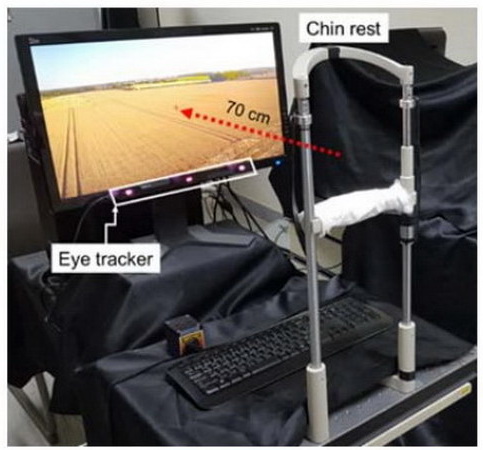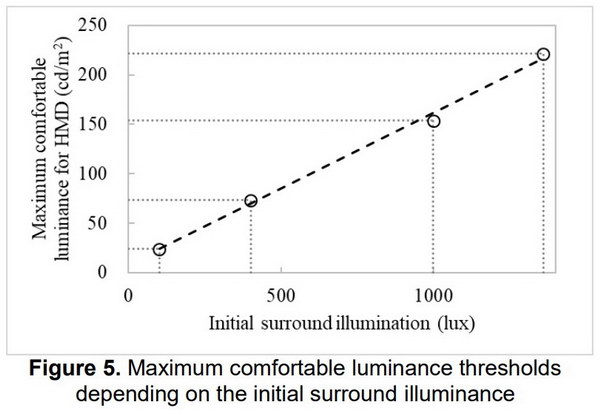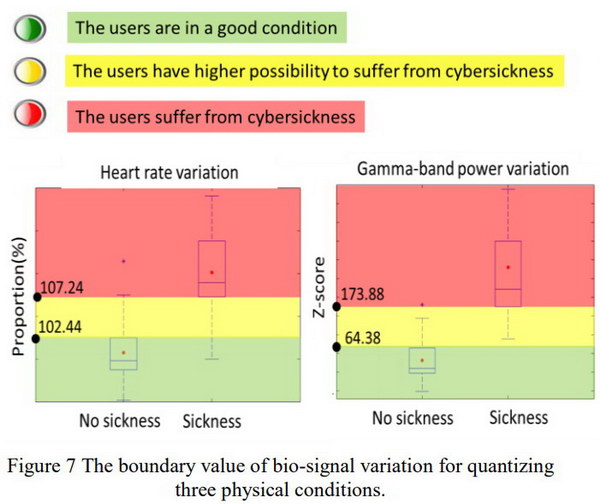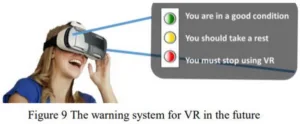The human factors of VR and AR HMD systems are not well understood. The results of the studies presented at SID’s Display Week just scratch the surface and a lot more human factors research is needed before HMDs can reliably be used without problems such as VR sickness.
 The experimental setup for testing eye-tracking for brightness control. (Source: SID 2018 paper 23.2)
The experimental setup for testing eye-tracking for brightness control. (Source: SID 2018 paper 23.2)
Most eye tracking and foveated rendering schemes use the technique to increase the perceived resolution of a NED. In paper 23.2, titled “A Novel Low-Power OLED Driving Method Based on Gaze Tracking,” Jeong-Sik Kim and his colleagues at Kyung Hee University have another goal: reduce the power consumed by the OLED microdisplay by showing the foveal region at high brightness and the peripheral regions at reduced brightness. This technique reduced power consumed by about 27%. A psychophysical experiment showed this happened without degradation in quality of experience (QoE). The power saved can be used either to extend the battery life or to increase the brightness in the foveal region.
 (Source: SID 2018 paper 65-1)
(Source: SID 2018 paper 65-1)
Paper 65-1 was titled “Maximum Comfortable Luminance of Head Mounted Display under Various Surround Illuminances” and was by Hyeyoung Ha and her colleagues at UNIST and Samsung Display. This human factors study looked at how comfortable viewers were with the VR HMD when they first donned the HMD, after having become adjusted to the ambient lighting. The results are shown in the image above. Since VR HMDs are typically set at about 150 cd./m² brightness, perhaps the key finding of the study is that if a user is accustomed to a typical 500 lux office environment, when he dons the 150 cd./m² HMD he will find it uncomfortably bright. When asked how long this discomfort lasted, the speaker said that had not been investigated. She added that accommodation to changed brightness conditions typically took about two minutes, she expected that the discomfort would last no longer than that.
 Sensitivity to various kinds of artifacts in the Google study for two different images. Eccentricity is the angular distance from the center of the image and down-sampling size is the size of the region in the down-sampling algorithm. (Source : SID 2018 paper 65-2)
Sensitivity to various kinds of artifacts in the Google study for two different images. Eccentricity is the angular distance from the center of the image and down-sampling size is the size of the region in the down-sampling algorithm. (Source : SID 2018 paper 65-2)
When images are rendered for VR HMDs, they are often down-sampled in the periphery of the display area as a simple version of foveal rendering. This paper (65-2) titled “Sensitivity to Peripheral Artifacts in VR Display Systems” by David Hoffman and his colleagues at Google, investigated the sensitivity of five observers aged 25 – 40 to artifacts introduced by various methods of down-sampling. These down-sampling methods produced three types of artifacts: blurring, aliasing that was temporally stable and aliasing that was temporally unstable. These temporally unstable artifacts were produced when down-sampling was used to reduce the resolution of a single frame without consideration of adjacent frames. They found that the temporally unstable artifacts were the most unacceptable, not surprising since it is well known that human peripheral vision is very sensitive to motion.
 (Source: SID 2018 paper 65-3)
(Source: SID 2018 paper 65-3)
Paper 65-3, titled “The Quantization of Cybersickness Level Using EEG and ECG for Virtual Reality Head-Mounted Display” authored by Yi-Tien Lin and her colleagues at National Chiao Tung University, addressed the issue of cybersickness (AKA VR sickness) head-on. One of the issues of cybersickness is it is a qualitative, self-reported problems. The authors of this paper worked on a quantitative method of detecting and predicting cybersickness that did not depend on self-reporting of the problem. The authors examined EEG data acquired by the nGoggle HMD (discussed elsewhere in this special report) and ECG data from electrodes put on the subjects skin. Twenty-five subjects, including six females, ranging in age between 20 to 31 years old were the subjects of the test. Each subject was shown three different videos on the HMDs, a static video which caused few cybersickness symptoms, a boating video in a first-person perspective which caused obvious cybersickness and a roller coaster video also in a first person perspective that also caused obvious cybersickness symptoms in most viewers.
(Source: SID 2018 paper 65-3)
The researchers found two signals that seemed to correspond to the onset of cybersickness and could be used as a warning sign for VR HMD users. The first was heart rate variation, with heart rate increases to 102% to 107% of a subject’s normal rate an indication of the onset of cybersickness. The second was the amplitude of the gamma-band brain waves, with a gamma-scope value of 64 – 173 indicating the onset. The authors envision that one, the other or both of these measures could be incorporated into future VR HMDs to warn users of potential problems.
One problem with human factors research it is it time consuming since it normally needs multiple test subjects and commonly focuses on one narrow human factors issue. Given this, it can take years or decades to build up a consistent human factors framework for a new display technology such as VR or AR HMDs. –Matthew Brennesholtz

